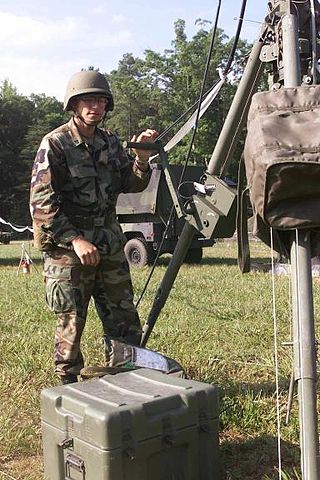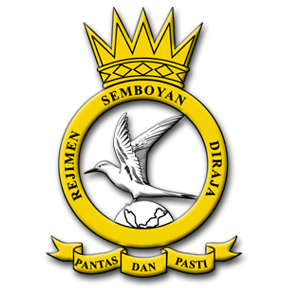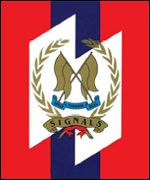Related Research Articles

The 1st Commando Regiment is an Australian Army Reserve special forces unit, part of Special Operations Command with an integrated structure of regular (full-time) soldiers and reserve (part-time) soldiers, which together with the full-time Australian Army 2nd Commando Regiment, provides the commando capability to Special Operations Command. 1st and 2nd Commando companies were raised in 1955 and were combined with 126 Signal Squadron (SF) in 1981 to form the 1st Cdo Regt. The regiment's two commando companies are the oldest sub-units within Special Operations Command. In 2008, the regiment deployed to Afghanistan to become the first Australian Army Reserve force element on combat operations since World War II. The regiment is the Command's capability lead for special warfare.

The Royal Corps of Signals is one of the combat support arms of the British Army. Signals units are among the first into action, providing the battlefield communications and information systems essential to all operations. Royal Signals units provide the full telecommunications infrastructure for the Army wherever they operate in the world. The Corps has its own engineers, logistics experts and systems operators to run radio and area networks in the field. It is responsible for installing, maintaining and operating all types of telecommunications equipment and information systems, providing command support to commanders and their headquarters, and conducting electronic warfare against enemy communications.
A foreman of signals is a highly qualified senior NCO or warrant officer signals engineering manager in the Royal Corps of Signals of the British Army and other Commonwealth armies. They undertake the role of equipment care specialist, with additional responsibilities for engineering and technical project management sometimes.

A signaller, signalman, colloquially referred to as a radioman or signaleer in the armed forces is a specialist soldier, sailor or airman responsible for military communications. Signallers, a.k.a. Combat Signallers or signalmen or women, are commonly employed as radio or telephone operators, relaying messages for field commanders at the front line, through a chain of command which includes field headquarters. Messages are transmitted and received via a communications infrastructure comprising fixed and mobile installations.
Historically, an armourer is a person who makes personal armour, especially plate armour. Historically armourers were often men, but women could also undertake the occupation: for example Alice la Haubergere worked as an armourer in Cheapside in the early 1300s and in 1348 Eustachia l’Armurer was training her husband's daughter, likely in the field.

The Royal New Zealand Signals Corps (RNZSigs) provides, co-ordinates and operates the communications networks of the New Zealand Army. The role of RNZSigs is to support other Arms by providing Communication Information System required for Command and Control of Units, Formations and Administrative installations in a theater of Operations and in the New Zealand support area. Modern signal equipment is essential to the army, demanding skilled operators and technicians. Because communications must be maintained even under the worst of conditions, signallers must be expert tradespeople. They must also accept a high degree of personal responsibility because the lives of soldiers can often rely on the fast and accurate transmission of battlefield information.
The Royal Australian Corps of Signals (RASigs) is one of the 'arms' of the Australian Army. It is responsible for installing, maintaining, and operating all types of telecommunications equipment and information systems. The motto of the Signals Corps is Certa Cito and is translated as 'Swift and Sure', signifying the aim of the signal service – that communication be carried out with maximum speed and certainty. Like their British counterparts, the Royal Australian Corps of Signals' flag and hat badge feature Mercury, the winged messenger of the gods, affectionately referred to by members of the corps as "Jimmy".

The Communications and Electronics Branch is a personnel branch of the Canadian Armed Forces (CAF). The army component of the branch is designated the Royal Canadian Corps of Signals.

The Corps of Royal Canadian Electrical and Mechanical Engineers (RCEME) is a personnel branch of the Canadian Armed Forces (CF) that provides army engineering maintenance support. All members of the corps wear army uniform. From the 1980s to 2013 it was called the Electrical and Mechanical Engineering Branch.

The Rejimen Semboyan Diraja is a combat support regiment of the Malaysian Army. It has the primary responsibility of establishing and maintaining secure military communications channels for the command and tactical elements of the Malaysian Army. It is also responsible for all electronic support, electronic warfare and early warning system for the Malaysian Army.

The Communications and Information Services Corps (CIS) – formerly the Army Corps of Signals – is one of the combat support corps of the Irish Defence Forces, the military of Ireland. It is responsible for the installation, maintenance and operation of communications and information systems for the command, control and administration of the Defence Forces, and the facilitation of accurate, real-time sharing of intelligence between the Army, Naval Service and Air Corps branches at home and overseas.

35T, previously 33W, is the Military Occupational Specialty (MOS) for the United States Army's Military Intelligence Systems Maintainer/Integrator.

No. 1 Radio School is based at RAF Cosford and forms part of the Defence School of Communications and Information Systems. Its motto is Thorough, which was the motto of the Royal Air Force Electrical and Wireless School.

Signals is the formation of the Singapore Army responsible for communications on multiple platforms and local networking on the battlefield. It also supports the Singapore Armed Forces (SAF) by developing the capacity for network-centric warfare in the form of Integrated Knowledge-based Command and Control (IKC2) and Command, Control, Communications, Computers and Intelligence (C4I) operations.
Within the British Army, Royal Corps of Signals, a soldier selected for Foreman of Signals training must be a SNCO Class 1 Communications Systems Engineer. They will normally hold a foundation degree Military Information Systems. On completion of the course, the soldier is promoted to Staff Sergeant if the rank is not already held, and assumes the appointment of Foreman of Signals and be awarded a BSc(Hons) in Management Information Systems. The holder of the appointment can be promoted through the ranks in line with current military policy from Staff Sergeant, to Warrant Officer Class 2, then Warrant Officer Class 1. To distinguish the appointment, a suffix of is used (i.e. SSgt WO2, WO1.

The Special Forces Qualification Course (SFQC) or, informally, the Q Course is the initial formal training program for entry into the United States Army Special Forces. Phase I of the Q Course is Special Forces Assessment and Selection (SFAS). A candidate who is selected at the conclusion of SFAS will enable a candidate to continue to the next of the four phases. If a candidate successfully completes all phases they will graduate as a Special Forces qualified soldier and then, generally, be assigned to a 12-men Operational Detachment "A" (ODA), commonly known as an "A team." The length of the Q Course changes depending on the applicant's primary job field within Special Forces and their assigned foreign language capability but will usually last between 56 and 95 weeks.

A warrant officer (WO) in the British Armed Forces is a member of the highest-ranking group of non-commissioned ranks, holding the King's Warrant, which is signed by the Secretary of State for Defence.
Sergeant major signals (SMS) is a British Army appointment, formerly known as sergeant major instructor signals (SMIS). Normally a warrant officer class 2 in the British Army, selection for this post was the culmination of many years of experience with modern radio communications systems. During their careers it was possible to be trained in several evolving systems for example the movement from Larkspur and Clansman to the more recent Bowman radio communication equipment. Their duties included training personnel by the development and execution of in-house and in-theatre courses, keeping their signal sergeants up-to-date with amendments to policies and equipment, equipment husbandry, equipment procurement and high level custodian protection of electronic and paper codes. They had to produce communications electronic instructions containing relevant daily frequencies and associated information for radio operators.
13 Signal Regiment is a signal regiment of the Royal Corps of Signals within the British Army.